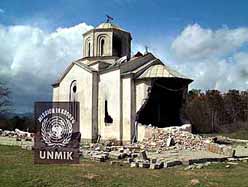Alarm
before Beheading
Recent events in the former Yugoslavia have culminated in the territories
of Kosovo and Serbia. Serbia, as an historical part of Europe, was
always stretched between the East and the West; being a place where
political influences have been clashing and a place where historical
events were not always in favor of its people. Opinions about Serbia were
divided even inside Serbia, as well as in Europe and throughout the world. In
this way, history is here again and is repeating itself.
 A
large number of cultural monuments originating from the last thousand
years stand in Serbian territory as firm proof of the spiritual presence
of one nation in this historical and geographical area. However, the reality
of the present time is very complex. Serbian culture is endangered and
Kosovo is the most drastic example.
A
large number of cultural monuments originating from the last thousand
years stand in Serbian territory as firm proof of the spiritual presence
of one nation in this historical and geographical area. However, the reality
of the present time is very complex. Serbian culture is endangered and
Kosovo is the most drastic example.
Since the period of the NATO bombing of Serbia in 1999, Kosovo remains an unsolved enigma in the hands of those who do not care enough about this ancient cultural legacy, although it is protected by UNESCO.
Andrej Tisma, a contemporary artist, reacts to current world events and occurrences in the region with strong activism in his new video work entitled, “Civilized Beheading”. He documents recent events in Serbia and Kosovo and has collaged the parts together, connecting them with other similar historic events. The work is impregnated with music as a component of the core video. Themes used in the video resemble contemporary liturgical sounds combined with strong sounds of cutting wood, which contribute to the intensity of the visual effects.
The video begins with images of frescoes on monastery walls as remarkable proof of the cultural presence, transitioning to iconographic representation of saints, Serbian kings and czars, and the largest Orthodox temple of St. Sava which depicts historical facts. The interchanging of icons with imagery of disappeared and exterminated nations (such as the American Indians) is a unique comparison and rememberance of the past.
By
linking past and present historical events, Andrej Tisma leads the
viewer toward his goal, toward his dynamic and intensive message. By exchanging
iconic signs and inscriptions with the geographical landscapes
of Kosovo and Serbia, Tisma involves the viewer in an active way.
For example, he combines images of monasteries and churches with key historical
facts, such as the Turkish Sultan Bajazit’s beheading of Obilic,
the Serbian national hero.
The image of a stump as a symbol of beheading, along with scenes of ruined
monuments from the 12th and 13th centuries, and visual signs of KFOR,
NATO, and UCK (KLA) moving over existing damaged monuments, symbolically
indicates the cause and the offender. Are the Serbs surviving and facing beheading
again? The artist wants to answer this question, and his answer inspires
us.
After every beheading comes a resurrection!
Biljana Mickov
(From the catalog of Andrej Tisma's show "Civilized Beheading", "Nova" Galery, Novi Sad, 2007)